Why Do Mums Turn Brown?
While there can be many reasons for chrysanthemums turning brown, it’s usually down to one of three categories. These are environmental concerns, diseases, and simple natural causes. In this section, we will cover these categories and the specific problems that could be plaguing your plant. We’ll also give you solutions on how to fix the problems.
Environmental Concerns
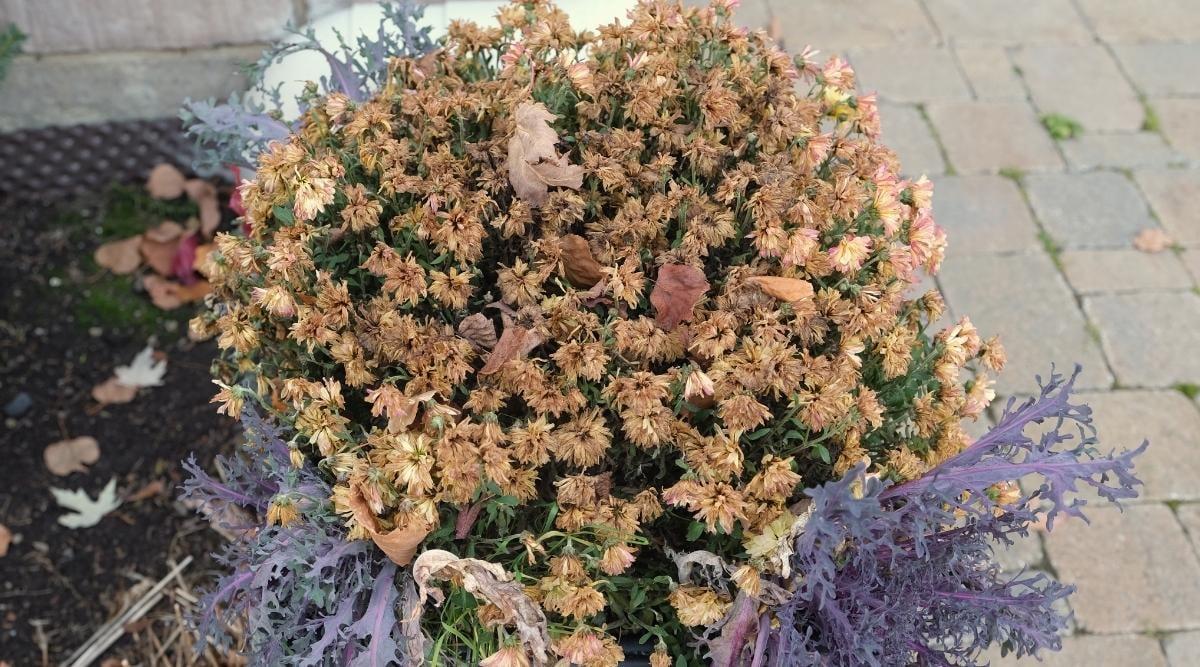
Environmental concerns have to do with the environment in which your mums are planted, including the care that you give them. While they are a fairly low-maintenance plant, it’s still important that you do your best to find a good place for them and work to fulfill their needs. Happier mum plants produce more mum flowers, after all!
You are viewing: Why Are My Mums Turning Brown
Sunlight
Chrysanthemums love the sun and thrive best when given full sun. While they can tolerate some shade, you will get the brightest and best blooms when they are given a lot of sunlight. Too little sun can mean the plant isn’t getting enough nutrients.
Photosynthesis is the process by which plants make their food, and this process requires sunlight. In this case, not getting enough sun can mean a lack of nutrition. Thus, the flowers will wilt and eventually turn brown. Take care that they get at least 6 hours of sun every day.
Bear in mind that if you live somewhere that is warmer, mums will benefit from shade given during the hottest hours of the afternoon. Too much sun can also be a bad thing, as the flowers can burn from the heat, thus drying them up and turning them brown, as well. The key is to strike a good balance, so that your mums get the sun they need without getting overwhelmed.
Soil
Chrysanthemums can thrive in different types of soil. However, it’s important that the soil has good drainage. Poor drainage in the soil can end up rotting the roots of your plants. This will turn your flowers brown, as well as spell the death of the whole plant. This is certainly a situation you will want to avoid at all costs, so take measures to improve the soil conditions of the plant. Mixing in sand and small gravel into the soil can help make for better drainage.
While on the topic of improving soil conditions, a lack of nutrition in the soil can also create difficulties for mums and turn them brown. Mums enjoy rich, fertile soils. They will be very happy to receive plant food or compost to enrich the soil they’re in. You can use a test kit to determine what nutrients your soil needs more of. Then, purchase a fertilizer that prioritizes those nutrients.
Bear in mind that using any fertilizer must be done with caution. Follow the instructions thoroughly and use only the recommended amount. Any less can mean little to no effect, which is a waste of effort. Any more, and you run the risk of burning your plant, which can also turn mums brown!
Water
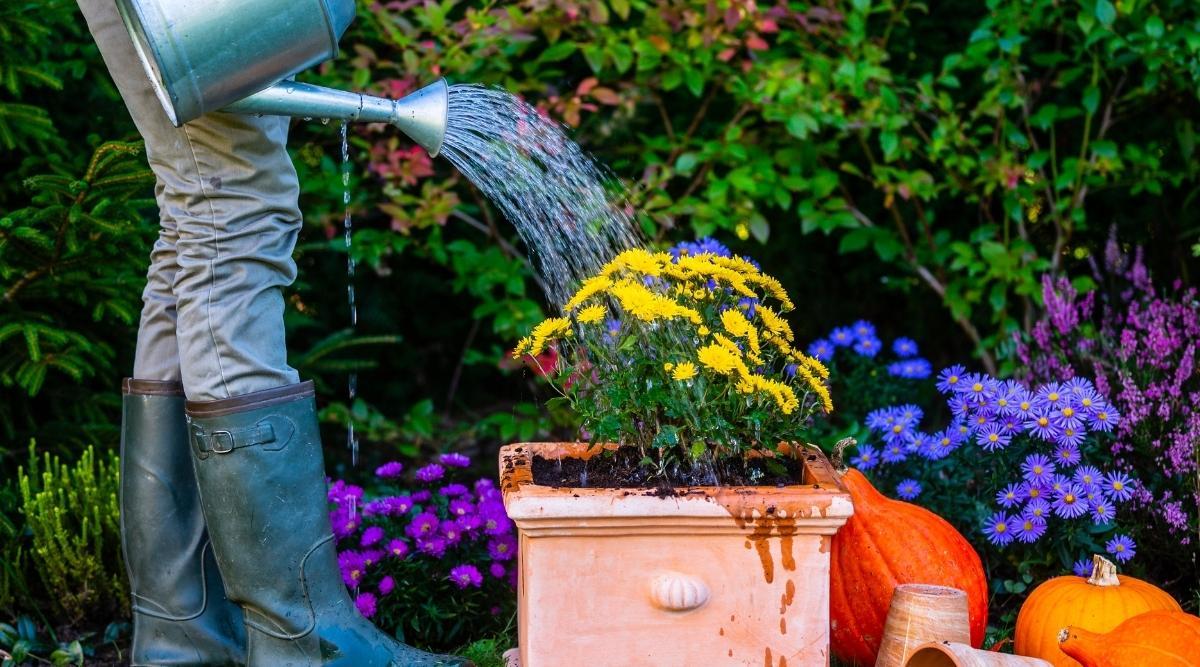
Chrysanthemums need a good amount of water, and not fulfilling their watering needs can easily turn them brown. For reference, during the growing period, mums will need around an inch of water per week. Once they’re established and the buds begin to open, you will need to give them this amount two to three times a week! They’re certainly quite thirsty, so take care that they’re getting the water they need.
However, over-watering can also be an issue. Too much water can mean suffocating your plant, which will deprive it of nutrients, thus wilting the flowers and causing that brown color. If you can’t tell when your mums need water, try touching the soil.
Good watering will have the soil still be moist after a few days, but never wet or soggy. Soil that is too dry is definitely in need of refreshment. Try to employ temperance; ensure that the plant does not become waterlogged in your quest to bring color back into your mums!
Weather
Garden chrysanthemums are pretty tolerant of most different kinds of weather, but any extremes will definitely cause them to brown as well. This is especially true for colder weather, which mums tend to be subjected to more often since they’re a fall-season plant. Early hard frosts can cause your mums to wilt and turn brown.
Read more : Why Does My Water Bottle Smell Bad
If you know the temperature is going to dip below 28 degrees Fahrenheit for more than 4 hours, do your best to cover your mums to protect them from the cold. The same can be said for any forecasted heavy rain, or even hail.
Drought will also be detrimental to your chrysanthemums’ health. If you live in a very dry area, or expect higher temperatures that will dry the soil out, ensure that you water your blooms more frequently. Chrysanthemums enjoy a little bit of humidity, but too much can discolor the flowers as well. Good air circulation in the soil can prevent the humidity from causing rot and other diseases, thus keeping them in their regular colors.
Diseases
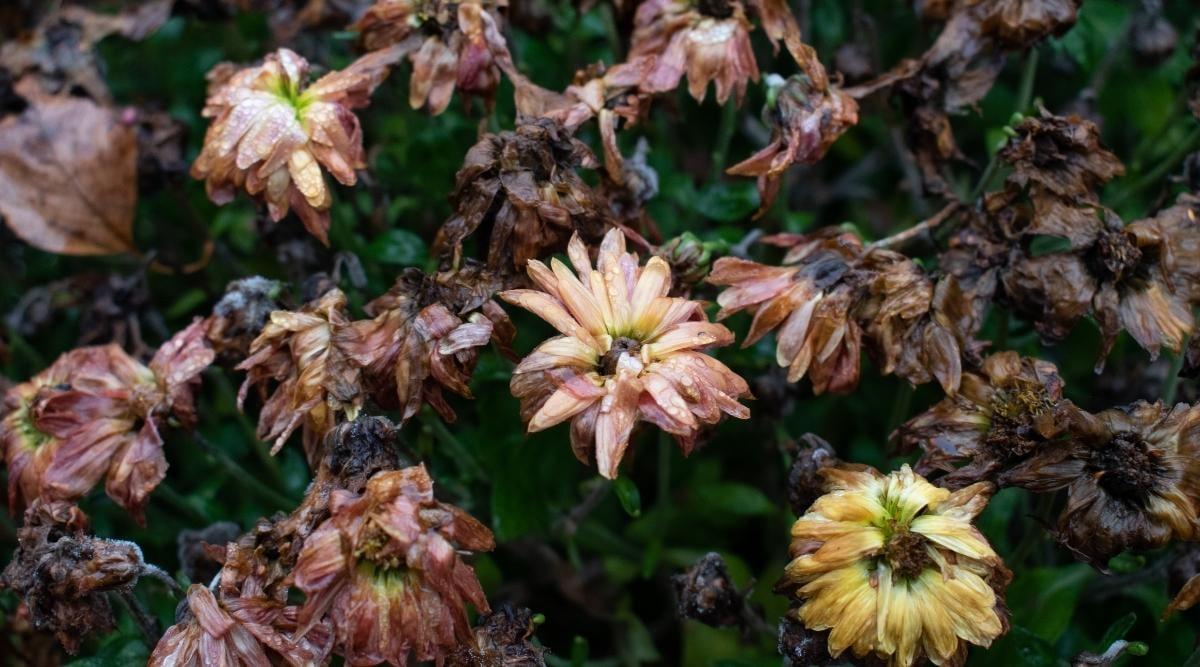
Disease can certainly be devastating to your chrysanthemum plants, very easily turning their blooms brown. There are a few different causes of disease in chrysanthemums; we’ll be covering the 3 most common ones here. These are fungal diseases, bacterial diseases, and pest infestations that cause disease. Getting these under control can mean saving all your mums and getting them back to their gorgeous color.
Fungal Diseases
Fungal diseases can cause plenty of trouble for mums, so it’s important to rid your plants of the disease in the soonest time possible. Treating the infection and containing it is key to fixing the problem; this must be done with both care and swiftness. One common fungal disease plaguing chrysanthemums is fusarium wilt. Let’s take a closer look at this disease.
Fusarium wilt is caused by the fungus Fusarium oxysporum. This spreads via your mums’ roots and into their vascular tissues. The plant will wilt and the leaves will turn yellow or brown. Flowers may not bloom, in some cases not growing at all. Overall growth is stunted, too.
It can be easy to mistake this fungal infection for root rot, since the key symptoms are the same. However, there are a few differences that can help you identify the issue. Fusarium wilt will sometimes cause wilting on only one part of the plant, whereas root rot causes the whole plant to wilt. One surefire way to tell is by looking at the roots. Fusarium wilt does not really affect the roots of the plant, so they will look healthy. Root rot, as the name implies, will rot the roots and darken their color.
Bacterial Diseases
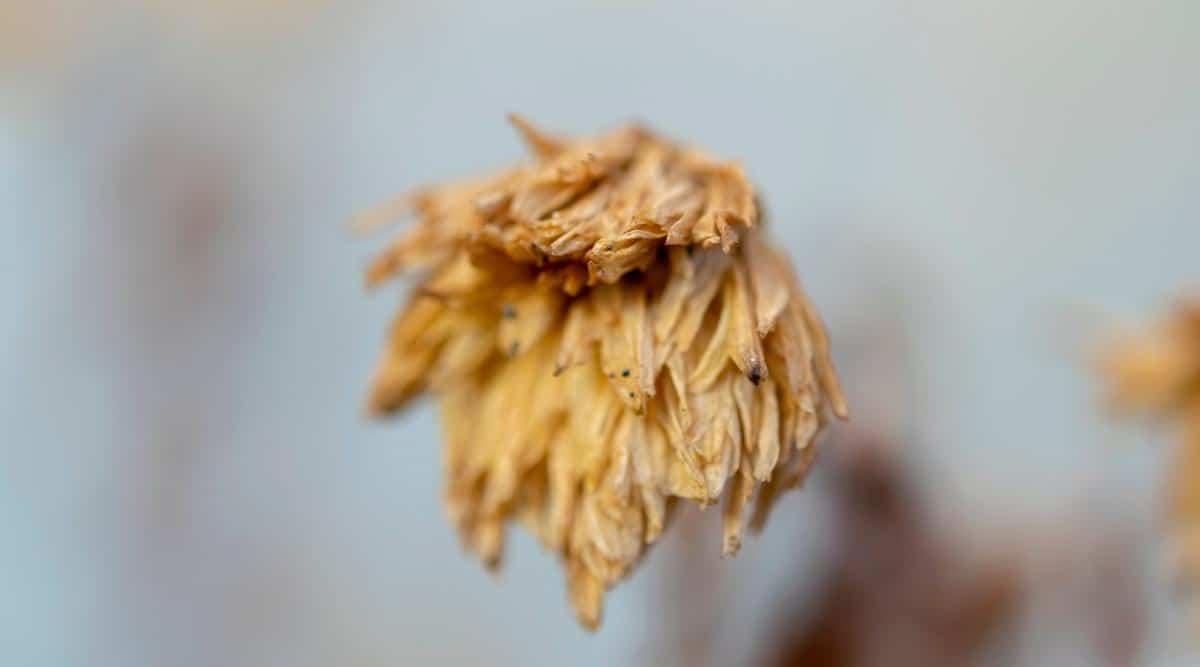
Bacterial diseases are another common problem that can turn your chrysanthemum plants brown. They can be difficult to control, so acting fast is imperative. One common bacterial infection that affects chrysanthemums is chrysanthemum leaf spot. This is caused by the bacteria Pseudomonas cichorii.
This disease is sometimes spread through the leaves of the plant. Even healthy looking leaves can carry the bacteria, so it can be difficult to determine if it’s there or not. Identification is key to mitigating the spread of the bacteria. Diseased plants will have irregular spots on the leaves, dark brown in color.
These will eventually dry out into a lighter color, and then crack. You will see this at the base of the plant; it will slowly make its way up, making the leaves curl up and cause blight in both new and established flowers. The spots on the leaves will be damp; this is where the bacteria thrives. Be careful when handling these plants. Try to avoid touching them while they are wet, as this can spread the bacteria to healthy plants.
Pest Infestations
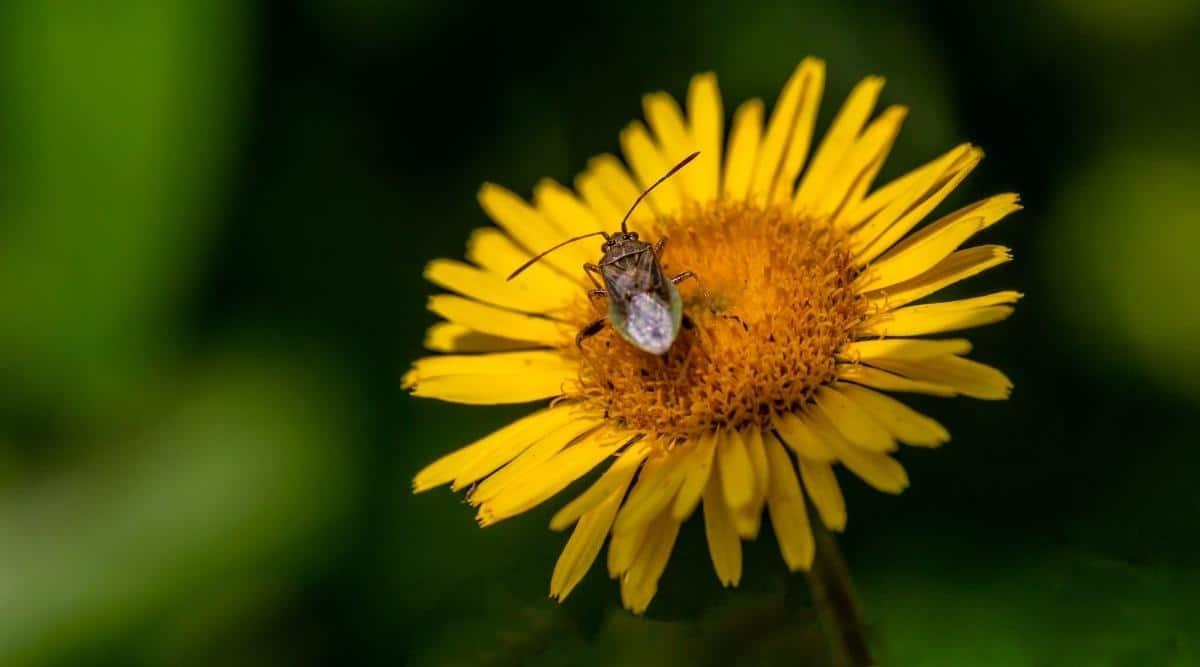
Chrysanthemums can turn brown as a result of diseases spread by pests. All plants are susceptible to pest infestations, after all, even the hardy mum. Many pests can bring problems to the plant that will cause it to discolor and turn brown.
Many pests that plague chrysanthemums tend to be quite small. Thrips and mites are some of them; they’re certainly pretty difficult to spot. If you suspect an infestation, try placing a piece of white paper, cloth, or canvas under the leaves. Gently shake the plant, then check for black or red dots. You’ll know they’re pests if they move.
Other pests to watch out for are aphids, earwigs, slugs, and snails. These can all bear diseases that will harm your plant, as well as damage the foliage. To treat the problem, you can spray insecticide or insecticidal soap onto the plant. Monocrotophos (0.04%) can be particularly useful for thrip infestations. Once you have gotten rid of the pests, the browning should cease and your plant will come back into good health.
Natural Causes
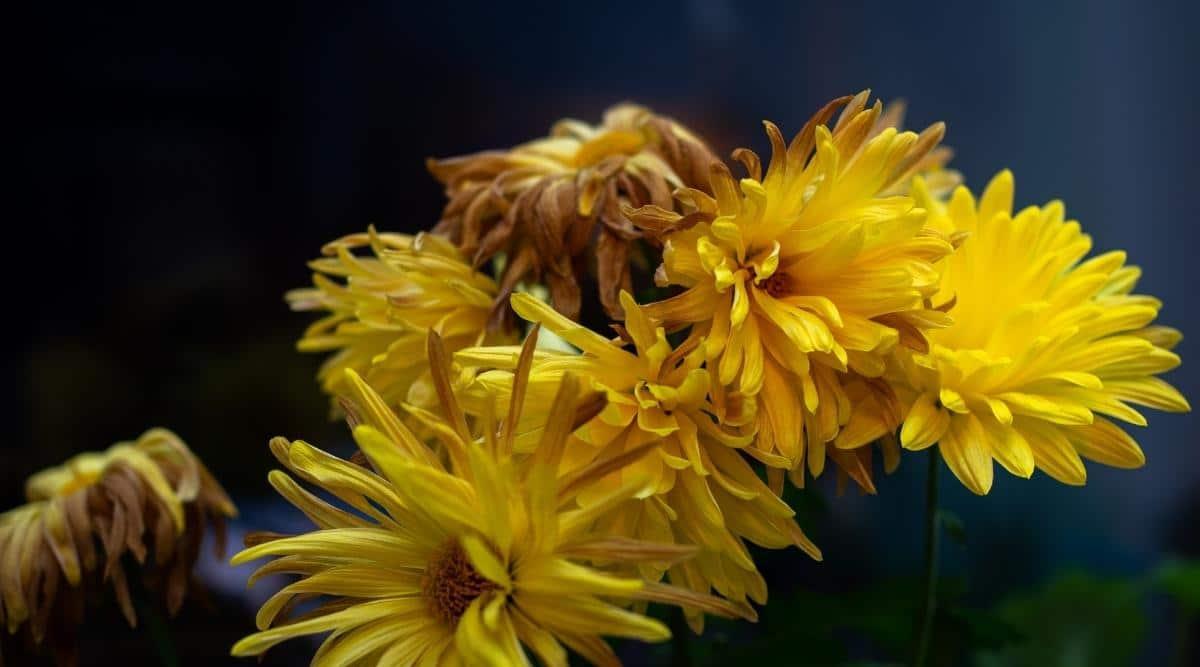
Lastly, your chrysanthemums may be turning brown from simple natural causes. If you’ve ruled out all other possibilities, it’s likely that the browning is something natural that happens. This will eventually fix itself, so it’s rarely a cause for concern as long as you care for the plant properly.
Acclimation
Read more : Why Did Little Bear Leave Alaska Monsters
Acclimation may be the reason for your mums turning brown. Simply put, buying plants from nurseries will entail taking them from their comfortable environment, transporting them, and placing them in their new home. This can be a stressful process for the plant. As such, it could display symptoms that can cause alarm, such as wilting, drooping, lower leaves dying, and discoloration.
As dramatic as your mums are being, it’s important to be patient and care for them to the best of their ability while they adjust to their new surroundings. A few weeks of TLC should get them back in tip-top shape, with the new leaves staying green, and the flowers being vibrant.
Life Cycle
The final reason your mums could be turning brown is because of their natural life cycle. While they are fall flowers, the winter will also put them into dormancy. They will eventually turn brown and fall away when they have finished flowering for the year.
In this case, if you have cared for them properly, it’s simply time to bid them goodbye for the year, thanking them for the gorgeous blooms they’ve graced your garden with. If you’ve been diligent with addressing their needs, they should come back in time for another spectacular show when the next autumn comes.
Caring For Mums After Browning
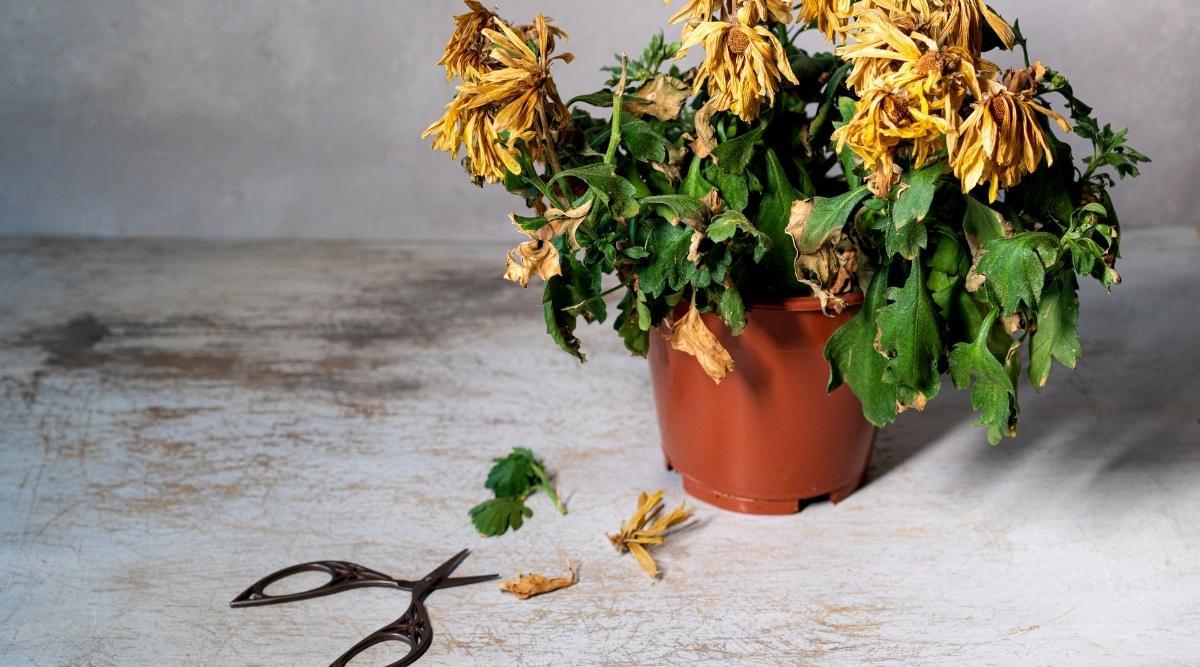
Generally, being hardy plants, chrysanthemums can withstand most bad conditions that happen to them. After the leaves or flowers have turned brown, you can try to prune the affected areas. This will encourage new growth in the correct color. In fact, you can cut back the plant to an extreme degree if the damage has been very bad. It will grow back healthy in no time at all.
Since your plant will be convalescing after you have treated the cause for their browning, you should work hard to keep an extra close eye on them. Being vigilant and attending to their needs with greater care should perk them back up again. Fortifying the soil with hearty organic matter should also give them a nutrient boost, just be sure not to overfeed. Mulching the soil is also a great idea, and will help protect the roots of your chrysanthemums.
Browning Prevention
Preventing your mums from turning brown starts with understanding their needs better. Now that you’ve read through this article, you can proceed with greater confidence. Here are a few good ways to prevent mums from browning.
In the case of clearing up an infection, you can prevent more mums from turning brown by being thorough with your clean-up job. Dispose of infected plant matter properly, ensuring no diseased tissue is left behind, even as debris. We cannot stress the importance of thoroughly cleaning your tools when they’ve been used on diseased plants; this includes pots. Being hygienic with tools will mean better health for every plant in your garden.
If there is harsh weather forecasted, you can prevent browning by giving your chrysanthemums adequate protection from the elements. Covering your plants with a plastic tarp may sound like a simplistic solution, but it really works! Mulching as a means of protecting against frost is also a good idea.
Prevent Early Flowering
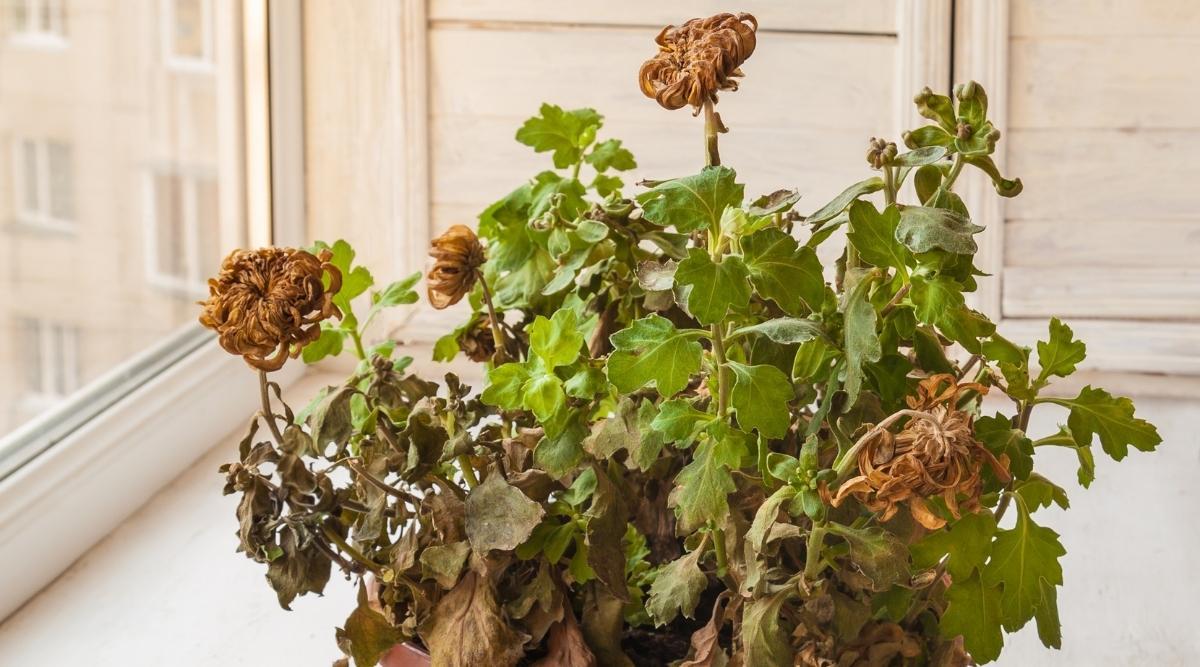
Lastly, a good tip is to prevent your mums from flowering early. If your mums flower too early in the year, they will turn brown much quicker than they should, as their flowering period will end before you want it to. Plant your mums in the spring as a way to let the plant adapt to the environment, establishing good health before showtime in the fall.
Sometimes, buds will form in late spring. You should pinch the tips of the growing stems with your forefinger and thumb. Do this once or twice a month until around July. This way, your blooms are basically guaranteed to arrive in the fall, when they should. This also gives the plant better chances of their blooms lasting six to eight weeks- a long time to enjoy their gorgeous colors! Then, they will follow their natural life cycle and turn brown at the expected time.
Final Thoughts
We hope that this article has given you the insight you need to know why your beloved chrysanthemums are turning brown. While there is a myriad of reasons, with mums being as hardy as they are, it’s usually not too difficult to make things right. By employing the solutions we’ve detailed, you can restore your mums back to good health.
Mums should give you a healthy amount of color that will perfectly complement the changing fall landscape, after all. While we all want to keep our flowers looking spectacular, Mums are generally inexpensive to purchase and to replant when all else fails.
Source: https://t-tees.com
Category: WHY

